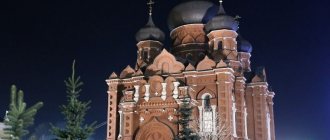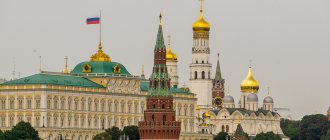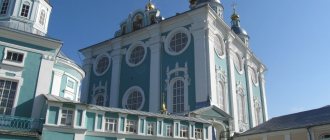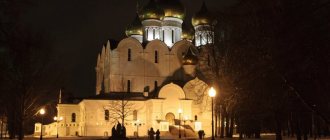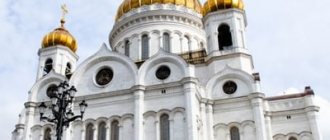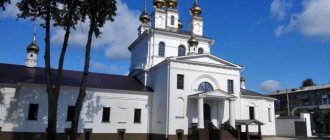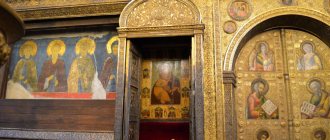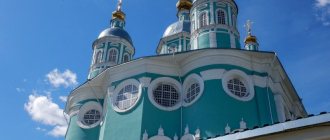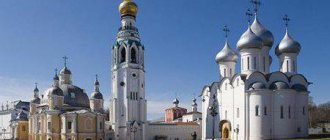| Kiev-Pechersk Assumption Cathedral |
The Cathedral in honor of the Assumption of the Blessed Virgin Mary (Great Pechersk Church)
, the main temple of the Kiev Pechersk Lavra, was located opposite the Holy Gates, in the middle of the central square of the Upper Lavra.
- Altar: Dormition of the Blessed Virgin Mary (main), ap. John the Theologian (lower right chapel, the only one preserved after the explosion of 1941), the first martyr Archdeacon Stephen (lower left chapel), St. John the Baptist (chapel in the northwestern corner), ap. St. Andrew the First-Called (choir chapel on the right) and the Transfiguration of the Lord (choir chapel on the left).
- Address: Ukraine, Kyiv, Kiev-Pechersk Lavra
- On the map: Yandex.Map, Google map
According to the testimony of Rev.
Nestor the Chronicler, the stone Church of the Assumption in the Pechersk Monastery was founded in 1073 with the blessing of St. Anthony by Abbot Theodosius and Bishop Michael (?). According to the Kiev-Pechersk Patericon, the Mother of God sent Greek architects from Constantinople to Kiev, appearing to them in the Blachernae Church with the words: “I want to build a church for myself in Russia in Kiev: I command you: take gold for yourself for three years and go build it... I will come and see the church myself, and I want to live in it... I want to call it by my name,
— and, handing the icon of the Dormition to the Mother of God, added, “
Let it be vicarious.”
| The Mother of God blesses the Greek. craftsmen for the construction of the Great Pechersk Church. Icon. 1st half XIX century (NKPIKZ) |
Coming out of the temple, the architects saw an image of a magnificent church on a cloud, and when they built it, they called it that for a long time - “like heaven.”
The founding and construction of the temple was accompanied by many miraculous events, demonstrating God's mercy and the intercession of the Mother of God. The land and one hundred hryvnias of gold were donated by the Kiev prince Svyatoslav for the construction of the church. The Varangian governor Shimon (baptized Simon) made a great contribution to the construction. Persecuted by his fellow tribesmen, one day he prayed in the house church at the family image of the Crucifixion and heard a voice commanding him to go to Rus', taking with him the belt and crown from the Crucifixion. Shimon equipped the ship and sailed to an unknown land. At sea, the ship was overtaken by a storm, and, losing hope of salvation, the Varangian prayed to God. He saw a church of unearthly beauty in the heavens and again heard a voice from above, predicting that now he would remain unharmed, and in the future he would be honored to participate in the construction of this church, where he would be buried. In the revelation, he was told the dimensions of the temple that was to be built, and the measure was indicated - the belt of the Savior. Divine Providence brings the Varangian to the Monk Anthony. Before the battle with the Polovtsians, the elder told Shimon that the Russians would be defeated, but he himself would survive, and in addition, he confirmed the predictions that a church would be built in the Pechersk monastery, in which Shimon would rest upon his death. Returning from an unsuccessful campaign, Shimon gave the monk a crown and a belt and told him everything that had become known to him from revelations about the construction of a “heaven-like” church.
Through the prayers of St. Anthony, the Lord, with miraculous signs, indicated the location of the future temple. In 1075 the main construction work began. Byzantine architects called by the Mother of God took part in laying out the plan of the church and laying the foundation. As the Patericon narrates, the money given by the Queen of Heaven for construction was “for three years.” The rough construction of the temple building was completed by 1077.
In 1083, icon painters came from Constantinople, miraculously hired by St. Anthony and Theodosius, and the Greek merchants, who witnessed this miracle, donated the mosaic to decorate the temple. Working for five years on painting the church, the icon painters witnessed wondrous miracles: the Lord helped the brethren decorate the church, as He had previously helped build it. According to the prediction of the Mother of God, they took monastic vows here and remained in the monastery.
Greek masters - architects, mosaists and icon painters - with the blessing of abbots Stefan and Nikon, created a monastic construction artel and an icon-painting workshop, which were engaged in the beautification of not only the Assumption Caves Cathedral, but also the churches of the St. Michael's Golden-Domed Monastery, the Klov Blachernae Monastery of St. Stephen and other churches. In 1951, archaeologists discovered an ancient mosaic workshop on the territory of the Lavra.
On August 14, 1089, the Assumption Cathedral was consecrated by Metropolitan John of Kyiv.
The church was distinguished by its extraordinary grandeur and beauty of its exterior and interior decoration. Its walls and iconostasis shone with gold and multi-colored mosaics and were decorated with many icons, the floor was paved with patterns of stone of different types, the head of the temple was gilded, and the cross on the dome was forged from gold. Above the Royal Doors of the iconostasis of the main altar, in a precious frame, was placed the greatest Lavra shrine - the icon of the Dormition of the Blessed Virgin Mary, according to legend, brought to Kyiv in 1073 by Greek craftsmen, to whom the Blessed Virgin Mary gave it to them in the Blachernae Church. The icon was inserted into a frame mounted in a large metal circle. On strong silk cords, the miraculous icon was lowered daily at the end of Matins and Liturgy for reverent kissing by the pilgrims.
In 1470 and 1722-1729, 1755, 1893 the church was reconstructed.
During the German occupation of Kyiv, on November 3, 1941, the cathedral was blown up. There are several versions: the cathedral was blown up by the Nazis; NKVD agents; partisans who intended to destroy the visiting Slovak President Tiso.
In 2000, the Assumption Cathedral was restored. As a result of reconstruction, the Predtechensky chapel acquired the appearance of a separate temple inside the Great Church. It contained all the remains found during the reconstruction, previously buried in the cathedral under cover.
Shrines
| Assumption Cathedral of the Kiev Pechersk Lavra, pre-revolutionary photo |
To the right of the iconostasis, at the southern wall of the main chapel of the Great Church, a silver ark with the head of the holy Equal-to-the-Apostles Prince Vladimir was kept, and to the left, in a small niche, were the relics of the first Metropolitan of Kyiv, Michael.
At the southern wall of the main chapel of the Great Church the coffin of St. Theodosius, abbot of Pechersk, and opposite him, in the northwestern corner, in the icon case - particles of the relics of all the Pechersk saints. Not far from this place, on a ledge of the wall, there was an icon of St. Anthony, before whom, according to legend, he stood in prayer during the services of St. Dimitry Rostovsky. In memory of this, an icon of St. was later installed here. Demetrius of Rostov.
In the chapel of St. The first martyr Archdeacon Stephen, near the iconostasis, in a silver shrine, part of his relics was kept - the index finger. This shrine was brought from the Moldavian Neametsky monastery by the Romanesque Archbishop Pachomius, who lived in retirement in the Lavra at the beginning of the 18th century. Currently, this shrine is located in the Church of the Exaltation of the Cross in a carved wooden shrine.
In the same Stefanovsky chapel, at the altar of the Church of the Baptist, there was a descent into the dungeon, where prominent figures of the Church and state were buried. Here rested the incorruptible relics of St. Pavel (Konyuskevich), Metropolitan of Tobolsk and Siberia.
The remains of many Russian princes, hetmans, Kyiv governors, metropolitans, bishops and archimandrites were buried under the floor of the Great Church. The ancient vestibule, in which the tomb of Constantine of Ostrog was located, also served as a burial place. Here after St. In ancient times, Theodosius was buried by princes, then by representatives of Lithuanian families and many men who became famous for spiritual and state exploits, such as St. Peter (Grave), Archimandrites Innocent (Gisel), Elisha (Pletenetsky), Pamva Berynda and others. In the old days, their tombs, which had tombstones with epitaphs on top, were covered with covers with portraits embroidered on them.
In the St. John the Theologian chapel, near the northern wall near the iconostasis, there was a miraculous icon of the Mother of God, called Igorevskaya.
In the same chapel, on the southern doors of the iconostasis, there was a revered icon of St. Nicholas the Wonderworker with a particle of his relics. At the southern wall of the Theological chapel, in a niche near the iconostasis, in a special reliquary, particles of the relics of St. John the Baptist, St. prophets, apostles, saints, martyrs and other saints - Greek, Serbian, Moldavian and Russian, as well as about 80 other shrines.
Read also
| Description and photos of attractions in Florence, Italy | What to see in Madrid? Description and photos of attractions | Stockholm, capital of Sweden. Monuments and all the sights of the old city | O. Greenland, capital Nuuk. Description and photo of the largest island on Earth | The best shops for shopping in Stockholm. Sales of Swedish clothing brands |
Architecture
| Kiev-Pechersk Assumption Cathedral, 1073 - 1078. Reconstruction of N. G. Logvin |
Initially, the Great Lavra Church had one hemispherical dome.
The Church of the Baptist, which once stood separately, also had a dome of a flattened hemispherical shape. On the site of the current side chapels and porch there were several chapels built in the 13th-16th centuries. In front of the Church of John the Baptist there was the chapel of Yeltsov, behind the Church of the Baptist there was the chapel of the Three Saints, behind it, closer to the altar, there was the chapel of John the Evangelist, and in the south-eastern corner there was the chapel of the princes Koretsky (in the name of the Holy First Martyr Archdeacon Stephen). St. Peter (Mogila), for symmetry with the northern side, added two more chapels to the southern side and erected four new domes. At the end of the 17th century, the side chapels were combined and formed the current chapels with two altars (they are already indicated on the plan of 1695); the northern aisle, dedicated to the holy first martyr Stephen, also included the ancient Church of the Baptist; the western chapels were replaced by a porch with four entrance doors. By the beginning of the 18th century, the entire ancient church was built up, its facade acquired baroque forms. The windows and doors were decorated like fabric draperies.
Before the destruction of the Assumption Cathedral in 1941, only the altar apses protruded from the ancient parts of the temple and were preserved in their entirety (except for the southern one, which was redone in the Lithuanian period, probably by Prince Simeon Olelkovich). The main apse in ancient times had relief images of the Mother of God and the Archangels standing on its sides: parts of these reliefs were kept in the Lavra sacristy. On the altar wall, a cross with the letters ІС has survived from antiquity. HS. NI. CA. The middle chapter and the dome above the St. John the Baptist chapel remained ancient.
For a long time it was believed that the ancient parts of the church, due to many reconstructions and rebuildings, were not preserved. However, as a result of research in the 19th and 20th centuries. Fragments dating back to the 11th century were discovered. Thus, not only individual Cyrillic letters were found on the plinths of the cathedral, but also entire words and phrases. On the walls there are preserved images of crosses, inscriptions and drawings made by master builders using raw mortar.
| Kiev-Pechersk Assumption Cathedral |
During archaeological excavations of the throne in 1963, fragments of a pot were discovered containing particles of relics wrapped in cloth. Tiles and pieces of smalt from the 11th century were also found there. This is all that remains of the 11th century throne. after reconstructions in 1729, 1755 and 1893. In the brickwork of the base of the throne of 1729, a slate pillar was discovered, driven into the ground. Perhaps this is part of the “corner stone” laid when the temple was founded. Excavations at the base of this stone showed that it was dug into the ground in the 11th century. The remains of an altar were also found. A large number of fragments of the original floor made of slate slabs inlaid with pieces of smalt were also found. In the memoirs of Pavel of Aleppo there are descriptions of the marble columns of the ancient altar barrier. According to legend, parts of the original iconostasis were used in the reconstruction of the churches of the Near Caves.
Interior decoration
| Assumption Cathedral of the Pechersk Lavra. General view from the north (before destruction) |
The original interior decoration of the temple can be judged from the descriptions given in the chronicles, “Pechersk Patericon”, “Synopsis” and in the memoirs of eyewitnesses.
They describe, first of all, the mosaics made of “gilded stones”, frescoes and marble cladding of walls and floors, which were striking in their beauty. In ancient times, the church was “mousia (mosaic) built not only along the walls, but also along the ground.” The ancient throne of the Great Church was made of brick. Initially it was covered with a marble board, and in 1744 it was overlaid with silver. On the altar there was a golden cross with particles of the blood of Christ, the pillar of flagellation and the rope from the pillar of flagellation. The iconostasis of this part of the temple was also “passionate,” that is, it had icons depicting the suffering of the Savior.
Neither the ancient painting nor the later one has survived. The life of St. Rev. given in the Patericon. Alipia gives us the opportunity to learn both about the content of the paintings and about the miraculous phenomena that he witnessed. When the icon painters were decorating the altar with mosaics, suddenly the face of the Mother of God was miraculously depicted on a high place and a dove flew out of it and flew “to the image of Spasov” and to the images of the holy martyrs Artemia, Polyeuctus, Leontius, Acacius, Arethas, Jacob and Theodore, particles of whose relics were presented builders by the Mother of God in Blachernae and laid in the foundation of the temple. The white dove flew from one image to another, landing on the saints’ hands, then on the head, and finally flying up to the local icon of the Mother of God, hiding behind this icon. Pavel of Aleppo, who saw the mosaics of the Great Church in the 17th century, describes the image of the Mother of God in the altar, similar to the one in Kiev-Sophia. Below it is an image of Christ surrounded by the apostles (Eucharist), and on the western wall of the church is an image of the Assumption, a mosaic floor in the altar and a marble mosaic plinth around the pulpit.
In the 18th century, mosaics were replaced by paintings, which were subsequently updated several times. Despite the ban on allegories in church painting issued in 1722, they abounded in the Assumption Church. Behind the throne, along with other subjects, Jesus Christ was depicted, crucified on the branches of an oak tree, near the altar - a Lamb, a Pelican - all in the spirit of baroque Ukrainian icon painting. Among the authors of this time, S. Kamensky is famous. The restoration of the painting of 1772 was carried out by Zacharias (Golubovsky). This work was continued in 1843 by Academician F. Solntsev. In 1893, the cathedral was re-painted by a group of artists led by V. Vereshchagin. Currently, attempts have been made to paint the choirs of the restored Assumption Cathedral.
Until 1941, in the Assumption Cathedral there was an iconostasis from the time of Hetman Skoropadsky (1708–1722), which had great artistic value. The icon of the Assumption, Pechersk saints and others were covered with luxurious vestments. Frames of stars were made around the icons. The royal doors were forged from silver with gilding. All of this is the work of Lavra jewelers, who were famous along with painters and carvers.
In the chapel of John the Theologian there was a cut-out iconostasis with pictures of the life of the Apostle John, Christ’s beloved disciple. Before the explosion in 1941, parts of the Church of St. John the Baptist, united in the 17th century, remained ancient on the northern outer wall. with the main temple. The dome over this part of the temple, as well as the vaults of the church itself, were ancient. In the 17th century The Church of the Baptist was divided into two floors, and its upper part was attached to the choir of the Great Church.
In the former Church of John the Baptist, the iconostasis was of the same work as in the Trinity Church on the Holy Gates and in the lower side aisles of the Great Church. In front of the iconostasis, Saint Peter Mogila placed the relics of the holy virgin Juliana, Princess of Olshanskaya. The princess was resting in an open shrine, so that one could see her beautiful white face, clothes, gold necklace and earphones. Relics of St. The Virgins of Juliana suffered in a fire in 1718 and are currently in a closed shrine in the Near Caves.
In pre-Mongol times, iconostases in Rus' were marble or wooden barriers, consisting of columns with low parapets between them and an architrave resting on the columns. In the tradition of that time, icons were not yet placed between columns on parapets. In the center of the barrier were the Royal Doors. The icons placed on the architrave made up the second tier and formed the deisis tier. The local icon, blessed by the Mother of God and brought from Constantinople, was in the center, above the altar pillars, which supported a frieze with a cornice and performed the function of the Royal Doors. In this barrier was also that wonderful image with which the miracle happened before the eyes of the saint. Alipia. Here, apparently, from the side of the altar, a golden crown and a golden belt of the Varangian Shimon were suspended, which were later taken by Vladimir Monomakh to Suzdal. The ancient iconostasis probably survived until 1482, and perhaps until the 16th century, when Prince Konstantin of Ostrog built a new six-tiered iconostasis, known from a copy cast with the blessing of Moscow Patriarch Nikon. In 1896, its upper tiers were removed in imitation of the original low altar screen.
ASSUMPTION CATHEDRAL OF KIEV-PECHERSK LAVRA
The Kiev Pechersk Lavra, one of the greatest shrines of Orthodoxy, was founded in the middle of the 11th century. And the foundation stone for the main church of the monastery. The Assumption Cathedral - it was called the Great Church - took place in 1073. But construction of the cathedral began only two years later, under Abbot Stephen in 1075, and was completed in 1078.
According to legend, the construction of the temple was preceded by a vision, which was seen by “one Varangian prince, named Simon,” who, through the prayers of St. Anthony of Pechersk, saved himself from death in the battle on the Alta River in 1068. Simon saw “on a cloud an image of the future new Pechersk church, and heard a voice commanding that a golden belt for the size of this church and a golden crown for decorating the altar be taken to St. Anthony.”
The cathedral was built by four “skilled builders” who came to Kyiv from Constantinople. Funds for the construction of the temple were donated by the same “Varangian prince Simon”, as well as the Grand Duke of Kiev Svyatoslav Yaroslavich. The cathedral was painted and decorated with mosaics by Byzantine “icon scribes”; Greek merchants brought precious smalt from Constantinople for mosaics.
The decoration of the cathedral with paintings and mosaics continued until 1089, after which it was consecrated. Contemporaries who saw the temple during its “youth” called it “like heaven”: “This heaven-like church is decorated with exquisite splendor inside and outside... The whole golden musia, that is, gilded stones, various patterns and variegated patterns, is wonderfully planted and beautifully painted with icons.” The head of the temple was gilded, and a golden cross was installed on it. The Great Church of the Kiev-Pechersk Monastery served as a model for a number of other buildings - in Rostov, Suzdal and other cities. But alas, the fate of this wonderful architectural structure turned out to be extremely tragic.
The cathedral was erected on a high hill above the Dnieper. This was the most complete example of an ancient Russian three-nave cross-domed church. As in most buildings of that time, a mixed masonry technique was used here, alternating strips of large flat bricks and stones, held together by wide strips of pink mortar.
The height of the temple was 46.8 meters, length - 44.7 meters, width with vestibules - 43.6 meters. The Assumption Cathedral differed from the temple buildings of the era of Yaroslav the Wise in its single-domed structure and laconic, upward-facing silhouette. Greek and Russian masters took part in decorating the cathedral with frescoes and mosaics, including the legendary Russian icon painter Alimpiy and the Kiev-Pechersk monk Gregory.
In 1230, the Assumption Cathedral suffered from a strong earthquake that occurred in Kyiv: “The great church parted on the floors and fell on top.” The dome of the temple, the southern wall and apses were destroyed. Restoration work was completed just before the Tatar invasion, during which the temple was again badly damaged. The Kiev Synopsis described the tragic events of 1240 as follows:
“The wicked barbarians smashed the stone monastery walls with battering rams and, having crushed them to the ground, entered the Holy Abode, cut off people of every rank, took others captive, and desecrated the very heaven-like Church of the Most Holy Theotokos of Pechersk, stripping of all its decoration and removing the gold-plated cross from the head of the church.” By order of Batu, the Assumption Cathedral was destroyed “up to the windows”, the staircase tower was destroyed and was no longer restored, the interior of the cathedral was severely damaged: its interior decoration, paintings and precious mosaics were almost completely destroyed.
After the Tatar pogrom, the Kiev-Pechersk Monastery was restored long and hard, and the Great Church “remained only in rubble for 233 years.” The Assumption Church was completely restored and re-consecrated in 1470, under the Lithuanian governor of Kyiv, Prince Semyon Olelkovich. In memory of this event, a terracotta triptych relief was built into the wall of the central apse of the temple, the left and right parts of which depict the founders of the monastery Anthony and Theodosius of Pechersk, and the central one - the image of the Mother of God, repeating her mosaic image that decorated the interior of the temple before the Tatar invasion. Now this triptych is embedded in the wall of the Great Lavra Bell Tower.
A year after the consecration of the restored temple, Prince Semyon Olelkovich died and was buried in the Assumption Cathedral. And in 1482, Kyiv was sacked by the Tatars, the Kiev-Pechersk Monastery was burned, and the Great Church was again badly damaged. For almost a hundred years the cathedral stood “in desolation,” and only at the end of the 16th century it began to “renew itself.” In later times, the Assumption Cathedral was rebuilt several times. Engravings from 1661 and 1693 have been preserved, indicating significant changes in the appearance of the temple. The huge fire of 1718 caused a lot of trouble in the temple, after which, in 1723-1729, large restoration work was carried out under the leadership of the architect I. Kalandin. Then the cathedral acquired the features of Ukrainian Baroque, and its walls, apses, pediments of the domes, windows and portals were richly decorated with stucco ornaments. Now there were seven domes, and not one, as before, of which the central one was gilded “through fire”, and the heads of the other six were covered with sheets of red gold. The drum of the main dome was painted with images of Old Testament kings and prophets. The exterior painting of the cathedral was last updated in 1824.
Over the years, the interior decoration of the cathedral also changed. In 1579, at the expense of Prince Konstantin Ostrozhsky, a new five-tiered iconostasis was made. This iconostasis died in the fire of 1718 in the church, and a new one, made in the Baroque style, was built with donations from Hetman Ivan Skoropadsky in 1723-1729 by the Chernigov master carver G. Petrov and icon painters A. Glinsky and S. Lubensky. The new huge multi-tiered iconostasis, which made an indelible impression on contemporaries, later became a role model, and its motifs were widely used by carvers of iconostases of many Ukrainian churches, built in the 18th century.
At the same time, eight masters of the Lavra icon-painting workshop, under the “supervision” of Hieromonk Zacharias Golubovsky, restored the wall paintings of the cathedral. And at the turn of the 19th-20th centuries, the cathedral was painted anew by a group of icon painters under the leadership of the artist V.P. Vereshchagin.
For centuries, the Assumption Cathedral of the Kiev Pechersk Lavra served as the tomb of many noble families. In the crypt of the cathedral, the Kiev governor of the 11th century, Jan Vyshata, known from the chronicles, and the sister of Vladimir Monomakh, the legendary Eupraxia, the epic “Apraxa the Queen,” the wife of the German Emperor Henry IV, were buried in the crypt of the cathedral. Here were the tombs of the princes Skirgailo, Ostrozhsky, Olelkovich, Vishnevetsky, Tyshkevich, Ukrainian church leaders and educators E. Pletenetsky, Z. Kopystensky, Metropolitan Peter Mohyla, rector of the Kiev-Mohyla Academy I. Gisel. In 1632, P. Berynda, an outstanding scientist and poet who compiled the “Slavic Russian Lexicon and Interpretation of Names,” was buried near the eastern wall of the cathedral. Here, in the Assumption Cathedral, the great Russian commander Field Marshal P.A. was buried. Rumyantsev-Zadunaisky. A tombstone by the sculptor I. P. Martos was installed on his grave. The outstanding Russian political figure P.A. is buried near the walls of the cathedral. Stolypin.
The Assumption Cathedral had nine thrones. In the altar of the Stefanovsky chapel, an ancient icon of the Mother of God of Byzantine writing was carefully kept, in front of which Prince Igor Olgovich, killed by the rebels of Kiev, prayed in the last hour of his life on September 19, 1147. In the Three Saints Chapel there was a rector’s sacristy, and nearby, in a special “chamber,” the library of the Kiev Pechersk Lavra was located.
The long-suffering Assumption Cathedral of the Kiev Pechersk Lavra was blown up by the Nazis in November 1941. Only fragments of the cathedral have survived to this day. A project for its restoration has long been developed. But so far visitors to the Lavra are greeted only by ruins...
